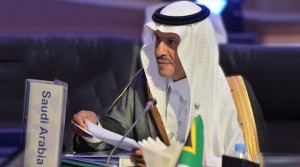2018-03-22 12:37:23
Distinguished guests, ladies and gentlemen.
It is my honor to welcome you all here today to this Carbon Sequestration Leadership Forum workshop. And my thanks to SABIC for hosting this important regional event. I would particularly like to welcome our visitors from overseas who have made the journey to be here with us today. I hope you have an enjoyable stay here although.Ladies and gentlemen. I will touch today upon four areas. First, a brief overview on Carbon Capture Storage and Utilization (CCUS). Second, a look at what the world is doing. Third, I will turn to what we are doing in Saudi Arabia. And finally, I will discuss this event.
The climate change challenge we face today is a global priority. With investment and focus on science and technology, I believe we can make a difference.
If you recall, the Paris Agreement’s aim was to reduce emission levels, not sources. The Carbon Sequestration Leadership Forum (CSLF) is a key part of the process, where all nations must play their role.
In essence, and I believe this is agreed by the global scientific community, research and development, and technology, are vital aspects of our shared aim to reduce emissions. Without carbon capture utilization and storage (CCUS), these targets cannot be reached.
This brings me to my second point, what the world is doing to help reduce emissions.
There are several key initiatives underway.
The Carbon Sequestration Leadership Forum is one. It matters because leading climate change experts advocate that carbon capture and storage deployment reduces the cost and risks of achieving sustainable development and climate goals. By working together within the CSLF and other related initiatives, we can achieve our aims.
The Global Methane Initiative is another important effort. It strives to reduce global methane emissions and advance the use of methane as a clean source of energy.
Saudi Aramco: Company General Use
The Clean Energy Ministerial is another vital example of the world’s efforts to curb emissions through the promotion of policies and programs that advance clean energy. The CEM is a key part of the international technology climate architecture.
The final initiative I will mention is Mission Innovation. It was launched in November in 2015, ahead of the 21st United Nations Conference of the Parties in Paris (COP21), with a goal to accelerate significantly the pace of energy innovation, reduce costs, and make clean energy technologies widely affordable worldwide while addressing the climate change challenge. It continues to do good work.
As you note, international technology initiatives spread through well to wheel and from R&D on basic science such as Mission Innovation (MI) to piloting such as (CSLF) through to deployment as we see in the CEM
Ladies and gentlemen, I will now turn to the third part of my introduction, outlining briefly what we are doing here in Saudi Arabia and how we are making a difference.
We are working on several initiatives that focus on reducing emissions.
SABIC, for example, has commissioned the world’s largest CO2 to chemicals plant in Jubail in the Eastern part of Saudi Arabia.
Then there is Saudi Aramco’s Uthmaniyah CO2-EOR demonstration pilot, commissioned in 2015. This pilot captures about 800,000 tons CO2 yearly from a natural gas liquefied plant, and transports it through 85 km pipeline for Enhanced Oil Recovery assessment in Saudi oil fields.
And we have the Saudi universities which are taking a pro-active role in advancing the innovation on CCUS. For example, King Abdullah University for Science and Technology is developing breakthrough materials and working on the challenge of CO2 to fuels.
So the challenge is real. The world is responding. And we in Saudi Arabia are investing time, money, research and scientific enquiry to play our part in this critical issue for our planet.
Ladies and gentlemen.
I would like to, finally, take this opportunity to underline the two primary objectives of these discussions here today.
Saudi Aramco: Company General Use
First, the aim is to develop recommendations for solutions to the economic, political, and technological challenges of Carbon Sequestration, Utilization and Storage in the Middle East and South Africa regions and to foster cooperation and networking between regional stakeholders with view to sharing knowledge, experience, and technical expertise for the mutual benefit of all.
I am confident that we have, here today, some of the key people in our regions to make this objective a reality. Therefore, I encourage everyone here today to make the most of this unique opportunity to share ideas, and to deepen and strengthen relationships. This information will be compiled and presented to Ministers who will represent the regions at the upcoming global CSLF meeting, giving them a clear idea of the outcomes that would benefit our different regions the most
ENDS
